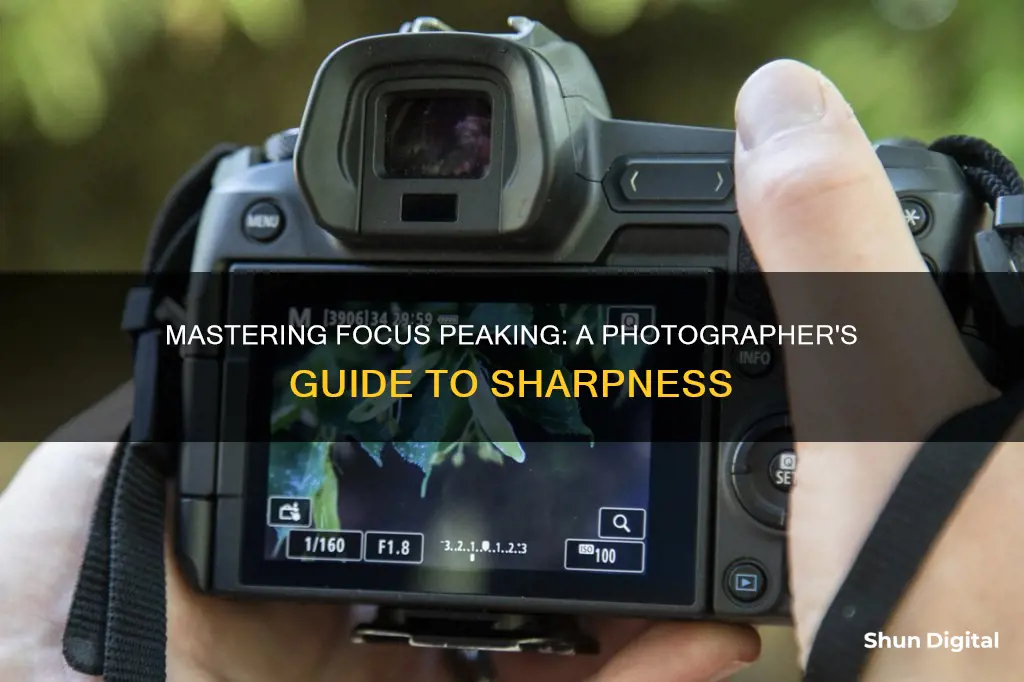
Focus peaking is a manual focus assistant that helps photographers and videographers pinpoint the areas of their image that are in focus. It does this by overlaying a colour on the areas of the image that are in focus, which is displayed in real-time on the camera's LCD screen. Focus peaking is particularly useful in situations where it is difficult to determine what is in focus, such as in low-light conditions or when there are a lot of fine details in the image. It is available on most mirrorless cameras and some DSLR cameras.
| Characteristics | Values |
|---|---|
| Purpose | To help photographers pinpoint the areas of an image that are in focus |
| Function | Overlaying a colour to highlight the areas of an image that are in focus |
| Real-time | Yes |
| Availability | Available on some cameras with manual focus |
| Use cases | Macro photography, portrait photography, product photography, landscape photography, videography |
| Visual aid | Coloured highlight |
| Algorithm | Analyses the scene, looking for areas of high and low contrast |
| Parameters | Sensitivity, colour of the overlay |
What You'll Learn

Focus peaking is a real-time visual aid
Focus Peaking is available in a wide range of camera brands and is applicable in both photography and videography. It is a useful tool in various photography genres, including macro, landscape, portrait, and product photography. In macro photography, focus peaking helps identify the sharpest areas of the subject, while in landscape photography, it aids in pinpointing the ideal focus point to capture detailed shots. Similarly, in portrait photography, it ensures that the subject's eyes or any crucial features are in perfect focus.
To use focus peaking, enable it in your camera settings, and while adjusting the focusing ring, a coloured overlay will highlight the sharpest parts of the frame. This overlay colour can typically be customised to complement the scene and ensure it remains visible.
While focus peaking is a valuable tool, it may have limitations in specific camera models or scenes. For instance, it may struggle in low-contrast scenes or extremely shallow depth-of-field situations. Additionally, it might not be as effective in low-light conditions, making it challenging to identify the in-focus areas. Therefore, it is essential to use focus peaking alongside other focusing methods to ensure optimal results.
Repairing Camera Batteries: A Step-by-Step Guide
You may want to see also

It highlights in-focus areas with a coloured overlay
Focus peaking is a manual focus assistant that helps photographers and videographers determine which areas of their image are in focus. It does so by overlaying a coloured highlight on the in-focus areas of the image, which is displayed in real-time on the camera's LCD screen. This allows users to see how the image's focus changes as they adjust the focusing ring on their lens.
The benefit of focus peaking is that it takes the guesswork out of manual focusing. Without it, users would have to rely on their eyes to estimate the plane of focus, which can result in images that are slightly out of focus. With focus peaking, users can be confident that the areas highlighted with the coloured overlay are in focus.
The colour of the overlay can usually be customised, allowing users to choose a colour that stands out against the scene being captured. Common colours provided by camera manufacturers include red, blue, yellow, green, and white. The sensitivity of the focus peaking overlay can also often be adjusted, with high sensitivity showing more of the in-focus areas and low sensitivity showing only the sharpest parts of the image.
Focus peaking is particularly useful in situations where it is challenging to determine what is in focus, such as in low-light conditions or when capturing fine details like flowers or leaves. It is also beneficial when using manual focus lenses, as it maximises the chances of getting a well-composed image with the right elements in focus.
While focus peaking is a valuable tool, it is not perfect and should not be solely relied upon for focusing images. In some cases, the coloured overlay can obscure too much of the composition, especially when working with a very shallow or very wide depth of field. Therefore, it is important to use focus peaking as a starting point and then fine-tune the focus using other techniques.
Camera Focus: How to Spot and Fix Blurry Photos
You may want to see also

It's useful for manual focus and low-light conditions
Focus peaking is a useful feature for photographers and videographers, especially in manual focus and low-light conditions. It is a manual focus assistant that helps users focus more accurately by highlighting the sharp areas of an image with a contrasting colour overlay. This overlay is displayed in real-time on the camera's LCD screen, allowing users to see how the image's focus changes as they adjust the focusing ring on the lens.
In low-light conditions, the naked eye may struggle to determine what is in focus. Focus peaking helps overcome this challenge by providing a visual indicator of the areas in focus. This is particularly beneficial when using manual focus lenses, which are often preferred for their sharpness when focused properly. With focus peaking, photographers can quickly assess the focus areas and make any necessary adjustments before capturing the image.
The feature is also valuable when working with fine details, such as flowers or tree leaves, where precise focus is crucial. By adjusting the sensitivity and colour of the overlay, users can ensure that the desired elements are in sharp focus. This level of control is especially advantageous in low-light situations, where achieving accurate focus through the viewfinder alone can be difficult.
Focus peaking is typically available in newer mirrorless cameras and can also be found in some DSLR cameras under names like "Focus Assist" or "Peaking Highlights." It is a powerful tool that enhances the manual focusing process, making it faster and more accurate, even in challenging lighting conditions.
The Evolution of Box Cameras: A Historical Perspective
You may want to see also

It's available on most mirrorless cameras and some DSLRs
Focus Peaking is available on most mirrorless cameras and some DSLRs. It was first introduced in camcorders and was used primarily for videography. However, with advancements in mirrorless camera technology, focus peaking has become a common feature in the photography world.
Most new mirrorless cameras have focus peaking as a built-in feature. It is also available in some older models from brands like Sony, Fujifilm, and Panasonic.
When it comes to DSLRs, focus peaking is available in most new models from Nikon, Sony, and Pentax, but only when using the live view feature. Canon DSLRs, on the other hand, do not have built-in focus peaking. However, it can be added to Canon cameras using third-party software called Magic Lantern, although this software is not yet compatible with many of Canon's newest DSLRs.
It's important to note that focus peaking is typically available only when using manual focus, and it can be a valuable tool for photographers using manual lenses.
Mastering Camera Rotation in Modding: A Step-by-Step Guide
You may want to see also

It's also known as 'focus assist' or 'peaking highlights'
Focus peaking, also known as focus assist or peaking highlights, is a manual focus assistant that helps you focus more accurately. It works in real-time, highlighting sharp areas with a contrasting overlay. With focus peaking activated, you will be able to see what part of the image is in focus before shooting. The colour overlay is displayed in real-time on your camera's LCD screen, so you can see how the image's focus changes with turns of the focusing ring on your lens.
Focus peaking is based on the principle that the sharpest areas of an image have a high contrast, which appears on the Live View display as either a white or coloured highlight on the edges and textures of objects. An algorithm analyses the image in real-time, and when an item comes into focus, the sharp edges create an intense exposure in that specific area of the picture.
Focus peaking is available on most newer mirrorless cameras and some DSLR cameras. It is ideal for scenes where it is difficult to determine what is in focus, such as shooting in low-light conditions or when there are a lot of fine details.
To enable the feature, go to the camera menu and look for "Peaking Settings". Usually, you will see three options: Display (On/Off), Level and Colour. The Display option will turn the peaking options on or off, and it is recommended to assign a button to this function for easy access. The Level setting determines how much is highlighted, with most cameras offering high, medium and low options. The Colour setting allows you to select the colour of the overlay, with white, red, yellow and blue being common options.
Keeping Your Camera Focused: Tips and Tricks
You may want to see also
Frequently asked questions
Camera focus peaking is a manual focus assistant that helps you focus more accurately. It works in real-time, highlighting sharp areas with a contrasting overlay.
Camera focus peaking works by detecting the edges and contours of objects within the frame where the contrast is highest (indicating sharp focus) and overlaying a coloured highlight on these areas.
Camera focus peaking helps you to figure out before you shoot what in your composition is in focus and what is not. It is especially helpful in situations where precise manual focusing is essential, such as macro or portrait photography.
To enable the feature, go to the camera menu and look for "Peaking Settings". Usually, you will see three options: Display (On/Off), Level and Colour. It is important to note that not all cameras have focus peaking built-in.







